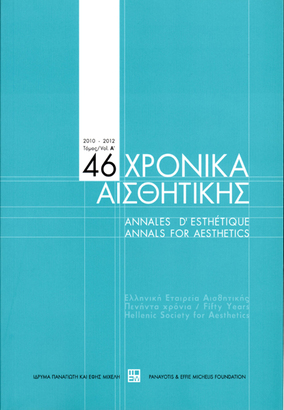Ο προσδιορισμός της αισθητικής εμπειρίας στην αισθητική θεωρία του Adorno
Part of : Χρονικά αισθητικής : ετήσιον δελτίον της Ελληνικής Εταιρείας Αισθητικής ; Vol.45, 2009, pages 3-24
Issue:
Pages:
3-24
Parallel Title:
The determination of aesthetic experience in Adorno’s aesthetic theory
Author:
Abstract:
Adorno does not consider his aesthetic theory as a theory of aesthetic experience. He sets it out as an aesthetics of art and of nature and, at the same time, as a critique of society. Even though the relation of theory and experience is crucial for the status of theory, Adorno lets aesthetic experience be an enigmatic aspect of his aesthetic theory. He rather avoids any emphatic explanation to the effect that the validity of his aesthetic theory depends on the results of aesthetic experience or on the trial and error test. Adorno insists on the priority of his theory arguing for the non-definable Other that transcends the affirmative ideology of the alleged self-sufficient society. Therefore, aesthetic experience is rather the sensibility towards the utopian traces of art and nature.According to Adorno, aesthetic experience as a human activity has its origin and foundation in life-experience. Adorno escapes the naturalistic interpretation of life-experience by establishing the primordial history (Urgeshichte) of the differentiation of the human from the world. This primordial event is “the step backwards in the face of the world” and initiates not only the individuation of the human but also human history. Nevertheless, this event does not indicate a schism between the human and the world.Adorno introduces the conception of mimesis as a primordial connection of the human and the world during the above differentiation. This peculiar ambivalence cannot be exhausted through conceptual means. It can only be presented pictorially in art. The open dialectics of the affinity of the human, and the things of this world re-establishes the significance of the pictures of art as the means of world-experience, and corresponds to the negative dialectics as a critique of the absolute priority of the concept. Aesthetic experience is the experience of pictures of art, since pictures can preserve the mimetic traces in spite of the false rationality, which produces and legitimates the schism between the human and the world in terms of domination over nature and over the human as nature. Aesthetic experience of art is the experience of a picture created by art, as far as art has the power to keep in presence the mimetic openness of society towards the utopian future, towards the Other. The aesthetic experience of nature is the experience of nature beyond the exploitation of nature. In this case, the beauty of nature casts a doubt over the realisation of meaning in modern society, and every affirmative definition of meaning in terms of substantialism and also of transcendentalism. Adorno’s conception of aesthetic experience is congruent with his aesthetic theory. We can assert its critical function in terms of Adorno’s aesthetic theory, but we also have to indicate its limits. The negativism of this conception almost diminishes the power of aesthetic experience as an experience of the presence of the artwork.
Subject:
Notes:
Αυτή η μελέτη έχει ως βάση το κείμενο της διάλεξης «Ο προσδιορισμός της αισθητικής εμπειρίας με ειδική αναφορά στην Αισθητική Θεωρία του Adorno», την οποία έδωσα στην Ελληνική Εταιρεία Αισθητικής στις 18 Οκτωβρίου 2006.




